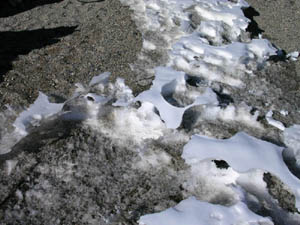 |
|
|
Home|Glossary|Links|Journal|Maps
Click on the picture to have a larger view Dirty snow melts faster than clean snow. So wind-borne sediments deposited haphazardly cause snow to have funny melt patterns. This is because dirt changes the snow's albedo. Albedo is the percent of incoming solar radiation reflected by a surface. Light colored surfaces, like fresh snow, reflect more radiation than dark surfaces, like dirty snow. This means that dark surfaces heat up more quickly than light surfaces. You may have noticed the effects of albedo when wearing a light versus a dark-colored t-shirt during the summer or when walking with bare feet from a white sidewalk onto an asphalt road. John and I have seen the effects of albedo on stream flow in the Lake Fryxell basin. Fresh snow may reflect 85% of incoming solar radiation. So when new snow fell on the glaciers, they stopped melting, and the streams stopped flowing. When the new snow melted after a few days, the relatively dirty glacier ice melted faster, and the streams started to flow again. Karen |
